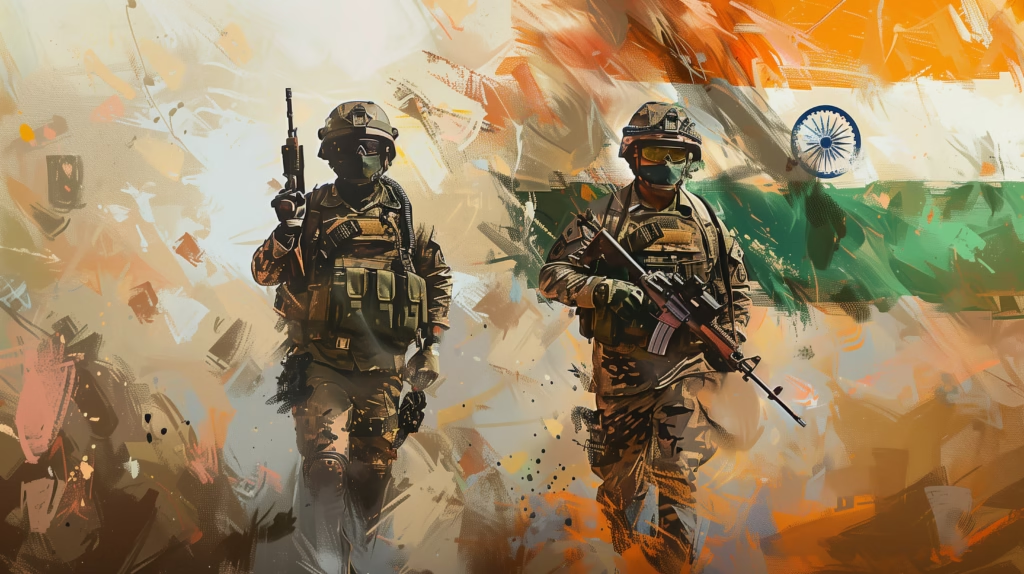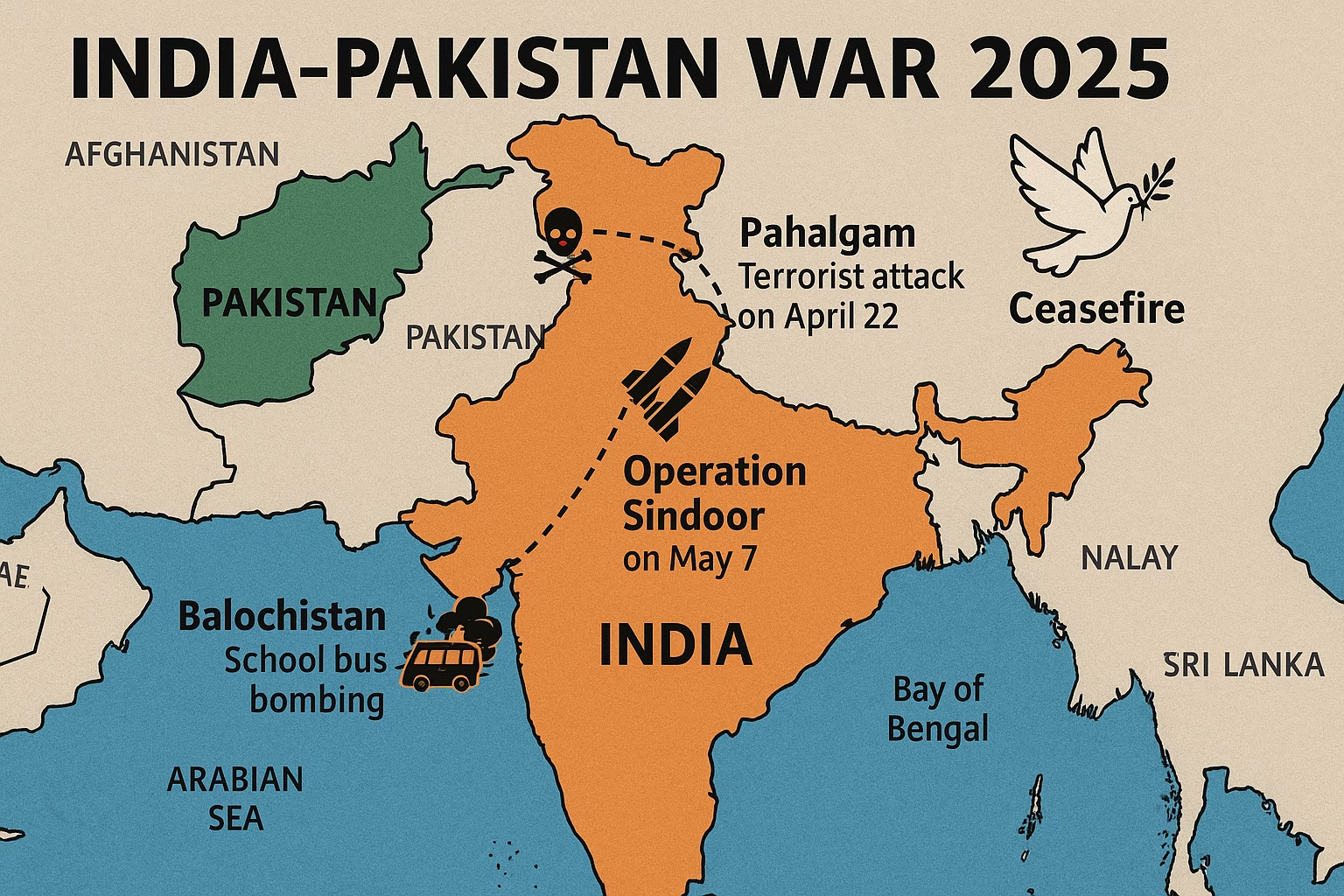Introduction:
India Pakistan War 2025: The year 2025 reignited one of South Asia’s most volatile flashpoints—India and Pakistan. Historically hostile neighbors, their latest clash shattered a fragile peace, sending ripples through global diplomacy, economics, and humanitarian systems. The India Pakistan War 2025 emerged not as a surprise, but as a fiery outcome of decades of mistrust, unresolved territorial disputes, and simmering extremism.
This war wasn’t a conventional battlefield event; it was a hybrid conflict—a brutal blend of boots on the ground, drone warfare, strategic airstrikes, propaganda, and cyberattacks. Civilians bore the brunt. International observers were alarmed. And for the people of both nations, it was a tragic déjà vu. But what exactly led to this devastating scenario? Let’s dissect every facet of the conflict.
India Pakistan War 2025: Understanding the Deep Historical Divide
The seeds of hostility between India and Pakistan were sown during the bloody partition of British India in 1947. That cataclysm birthed a bitter rivalry, particularly over the region of Kashmir—a paradise turned battleground. Three wars (1947, 1965, and 1999) and numerous standoffs followed.
The Indus Waters Treaty, a rare success story brokered in 1960 by the World Bank, has survived wars and rhetoric. Yet, even this landmark agreement faced pressure during the latest conflict, as India hinted at choking water supplies—a move heavy with strategic and humanitarian consequences.
Triggering Events: What Sparked the 2025 Conflict?
The spark that lit the 2025 inferno was the Pahalgam terror attack on April 22, which claimed 26 civilian lives. India held Pakistan-based terror groups responsible and launched Operation Sindoor, a swift military retaliation against targets it claimed were terrorist training camps within Pakistani territory.

Pakistan denied the allegations and called the strikes a violation of sovereignty. But by then, both countries were locked in a retaliatory spiral. Skirmishes flared, drones buzzed skies, and diplomatic bridges crumbled.
Military Engagements and Strategic Warfare
Unlike the past, this wasn’t an all-out invasion. Instead, it was a modern, multi-front conflict:
- Drone strikes became the weapon of choice. India’s indigenous drones neutralized suspected camps in Pakistan-occupied Kashmir.
- Airspace was closed across several regions, grounding civilian flights and heightening tension.
- Missile deployments were conducted as shows of force.
- Cyberwarfare hit infrastructure on both sides, disrupting communications and transport logistics.
This battle was more sophisticated and silent—covert operations and intelligence warfare played a dominant role.
Political Reactions: Diplomacy Under Siege
Prime Minister Narendra Modi asserted that India would no longer “tolerate terrorism from across the border.” His speeches, resolute and nationalist, resonated with domestic audiences. Pakistan’s Prime Minister Shahbaz Sharif responded with equal vigor, stating that “sovereignty shall not be compromised.”
Backchannel diplomacy was attempted, but mutual suspicion poisoned every gesture. The bilateral relationship hit its lowest point in decades, freezing peace talks indefinitely.
International Response: Mediation or Manipulation?
The United States, China, and the United Nations issued urgent calls for restraint. Speculation swirled that the U.S. mediated a ceasefire. However, India firmly denied third-party involvement, asserting it brokered peace through “mutual military dialogue.”
Russia, traditionally neutral, nudged both parties toward a truce. Meanwhile, Iran and Turkey issued stern warnings against further regional destabilization.
The international media framed the conflict as a ticking time bomb in a nuclear-armed region—an escalation that, if unchecked, could lead to global catastrophe.
Humanitarian Impact: Civilians in the Crosshairs
War is never clean. And in 2025, the line between soldier and civilian blurred even more. In Pakistan, a school bus bombing in Balochistan killed three girls and two staffers. In India, border towns faced evacuations, shelling injuries, and displacement.
Refugee camps swelled. Healthcare systems, especially in contested Kashmir, buckled under the pressure. Food supplies were rationed. Psychological trauma soared.
The humanitarian crisis highlighted the urgent need for neutral relief corridors and NGOs that can operate without political interference.
Economic Fallout: Trade, Sanctions, and Market Shocks
Both nations paid a heavy economic price. India suspended trade routes and withheld water under the Indus Treaty. Pakistan responded by halting airspace access, disrupting regional travel and supply chains.
Stock markets across South Asia dipped. Fuel prices surged. Agriculture suffered, particularly in Pakistan, where India’s upstream control over rivers became a pressing concern.
Western economies watched nervously, fearing a longer-term impact on regional trade and supply chains involving China, the Gulf, and ASEAN nations.
Media & Propaganda: The War of Words
Traditional and social media were weaponized. Indian news outlets aired exclusive footage of strikes. Pakistani media countered with civilian casualty reports. Twitter and YouTube flooded with misinformation, memes, and outrage.
WhatsApp disinformation campaigns escalated communal tensions. Governments imposed temporary internet shutdowns in volatile regions.
The battle for hearts and minds was as intense as the one fought on the borders.
Future Implications: Can Peace Ever Be Sustainable?
The India Pakistan War 2025 may have ended with a ceasefire, but peace remains precarious. Fundamental issues—Kashmir, terrorism, water rights—are unresolved.

Experts warn of a Cold Peace, where overt war is absent, but hostile intent simmers just below the surface. Others call for Track II diplomacy: people-to-people initiatives, student exchanges, cultural programs, and civil society engagement to rebuild trust.
Military deterrents can stall violence, but only dialogue can dismantle hatred.
Conclusion: A Moment to Reflect, a Call to Act
This conflict reminded the world that nuclear-armed neighbors cannot afford miscalculations. The war left wounds—both literal and metaphorical. It exposed how volatile geopolitics, unresolved history, and nationalism can combine into a deadly cocktail.
But it also revealed pathways to peace—through restraint, humanitarian outreach, and unbiased dialogue. The future of South Asia doesn’t have to be shaped by bombs and barbed wire. It can be rewritten through courage, clarity, and compassion.
Frequently Asked Questions
What caused the India Pakistan War 2025?
The war was triggered by the Pahalgam terrorist attack on April 22, 2025, which killed 26 civilians. India blamed Pakistan-backed militants, sparking military retaliation.
What was Operation Sindoor?
It was India’s codename for a series of missile strikes against alleged terrorist camps across the border in retaliation for the Pahalgam attack.
How many people died during the conflict?
Exact numbers are unclear, but dozens of civilians and soldiers on both sides were confirmed dead or injured. The full toll remains under verification.
Was the Indus Waters Treaty violated?
India suspended water flow from certain rivers to Pakistan as a strategic move. While not officially voiding the treaty, it marked a significant escalation.
Who brokered the ceasefire?
There are conflicting reports. While the U.S. was rumored to mediate, India stated it resolved the crisis bilaterally.
Will there be more conflicts in the future?
If core issues remain unresolved, future conflicts are possible. However, diplomatic efforts and civil engagements can help de-escalate tensions.










